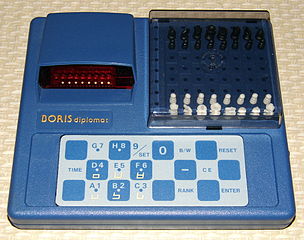
The image above is from Wikimedia Commons, licensed under the Creative Commons Attribution Share-Alike 2.0 Generic License, and is thus available for your use under the same terms.
Its author is Joe Haupt.
An earlier page dealt with the pocket calculator as a forerunner of the microcomputer. While electronic pocket calculators worked because they contained within themselves an electronic digital computer of sorts, it was possible for that computer to be too small to be useful as the heart of a device that would be considered a full-fledged computer.
While today's desktop microcomputers wield an immense amount of processing power, far eclipsing that of the most powerful mainframes of the 1960s or even the 1980s, just as a PDP-8, tiny though it was, was still powerful enough to be what is commonly thought of as a computer, either running programs in BASIC, or compiling programs in FORTRAN so they can run faster later, so too was even the Intel 8008 powerful enough to be the heart of a real computer.
While the processors that were used in desktop computers became more powerful, processors as powerful as those used in them in previous years became less expensive. And thus the point was reached where placing an 8-bit processor, and later even a 16-bit processor, inside a special-purpose device ceased to be so exorbitantly expensive as to be unthinkable.
Of course, I have no intention of covering the entire field of embedded computing in this section. I fear I lack the specialized knowledge, the interest on my own part, and the writerly flair to make the story of how microprocessors allowed adding features to toasters, or replaced relay logic or timing cams in washing machines, one that would fascinate the general reader. For that, one must look elsewhere.
One category of device which is as obviously performing a computational task of some sophistication as a scientific pocket calculator computing the value of a log or trig function is even usually called a computer, even if it isn't user-programmable.
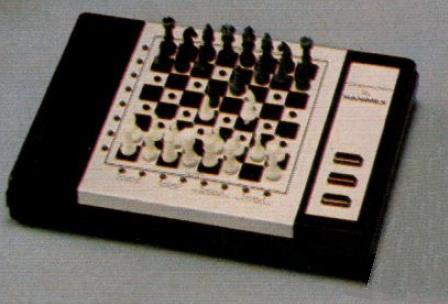
The first chess computer I owned, as it happens, could have squeaked into the same page as discussed pocket calculators, as it was built around a 4-bit microprocessor, the Hitachi HD44801.
It was a version of the CXG-001 Sensor Computachess, on sale at Eaton's at a reduced price. It didn't have the CXG logo visible on it, however, but was a version sold under another name. Pictured at right is still another version, with the Hanimex brand name on it.
While it did not play Chess very well, since one entered moves by pressing down on the piece at its departure square, and then again at the arrival square, it was more sophisticated than the earliest chess computers, which required entering the departure square and then the arrival square on a keyboard in algebraic notation.
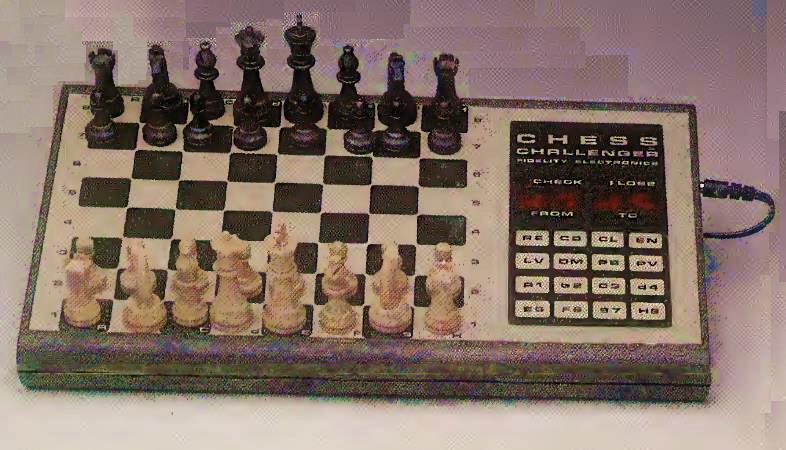
Pictured at left is the Chess Challenger 7 by Fidelity Electronics, the name of which indicates that it had seven selectable levels of chess play. This was of a similar type to their original Chess Challenger, which was one of the earliest chess computers to be available, and which was successful enough to popularize the idea of a chess computer.
 |
The image above is from Wikimedia Commons, licensed under the Creative Commons Attribution Share-Alike 2.0 Generic License, and is thus available for your use under the same terms. Its author is Joe Haupt. |
Another example of an early chess computer with keyboard entry of moves in algebraic notation, and a numeric display, is the Boris Diplomat, by Applied Concepts. It does have a pegboard with chess pieces, but that is only so that a separate chessboard is not required for portable play; it is an ordinary chess peg board which does not include any kind of electrical switch or sensor.
The image at right shows a unit that is blue in color; while some were made in that color, a brown color was more common.

At left is another machine from Applied Concepts, the Great Game Machine, although this image is of the unit as sold by Chafitz as the Modular Game System. It could play checkers or Reversi if different program cartridges were inserted; also, there were cartridges with programs specialized in opening play and endgame play.
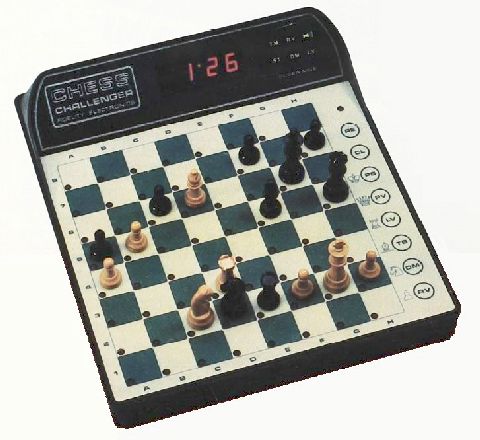
Pictured at left is a later chess computer also from Fidelity Electronics, the Sensory Chess Challenger 9. This was much larger than the Computachess portable chess computer shown above; the membrane sensor was the board surface itself rather than being below holes for pegs. Note, as well, that there was a LED on every square, instead of LEDs at the edges to indicate both the row and the column. And, again, its name indicated that it had nine levels of play.
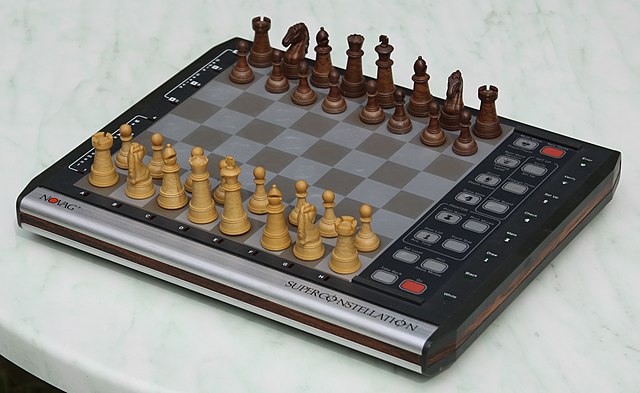 |
The image above is from Wikimedia Commons, licensed under the Creative Commons Attribution Share-Alike 4.0 International License, and is thus available for your use under the same terms. Its author is morn. |
In addition to Fidelity Electronics, Applied Concepts, and CXG, a number of other companies made chess computers. Novag, also an American company like Fidelity Electronics, made several chess computers recognized for good playing strength at the time and which had a stylish appearance. Their Super Constellation is pictured at right.
There were also some large and expensive chess computers, beyond the relatively ordinary ones pictured here, including ones that used the 68000 microprocessor, and there were some that would actually movie the pieces in response to the computer's moves - either by using strong electromagnets in the board to make the pieces slide, or even by having a robot arm to pick them up and move them.
Examples of chess computers that used the 68000 microprocessor (or, in some cases, even related ones that were more capable, such as the 68020) are: the various Mephisto S models, and then the less expensively packaged Mephisto Mondial 68000 XL, the Novag Diablo 68000, the Fidelity Model 6094 Excel 68000, and the CXG Sphinx 40 and 50.
While at first a 68000-based chess computer would have been an extravagant purchase at over $1,000, by 1988 some were available at just over $400.
Mephisto chess computers were originally made by Hegener and Glaser, and subsequently the rights to the line were purchased by Saitek (formerly SciSys), a Swiss company, but now Saitek has been bought by Logitech.
Milton Bradley made a chess computer, the Grand Master, which, while built around a 6502A 8-bit microprocessor, was still fancy because of another feature it had: magnets under the board would move the pieces automatically when the computer made its move. This chess computer first became available in 1983.

This was not the only computer with that feature. There was also the Fidelity Electronics Phantom, which worked in the same way... which was not surprising, as it was actually the same chess computer with a different name printed on it, and there was a chess computer by Novag which used a mechanical arm to move the pieces for the computer, the Novag Robot Chess Adversary from 1982. A newer chess computer with such a robot arm was brought out in 2008, the Novag 2Robot, and it was apparently available at a lower price.
Self-moving chess computers are still available today, but with much more powerful chess programs running on modern microprocessors, such as the Miko Chess Grand.
During the heyday of chess computers, devices similar in appearance for playing other board games were also made. There was the "Great Game Machine", which was a chess computer with interchangeable program modules, including some for games other than Chess. Fidelity Electronics made a Bridge Challenger, which required a special deck of cards with bar codes printed on them. Some later chess computers could also play checkers. And there was also Monty Plays Scrabble.
Of course, there were also many other handheld computer games which did not resemble chess computers in any way.
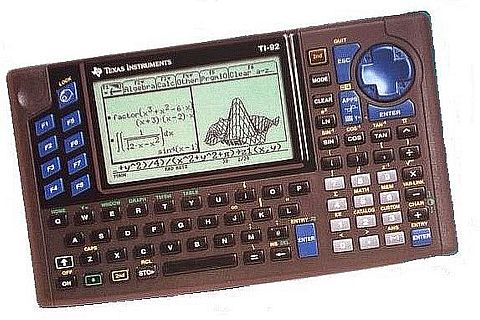
In April, 1995, Texas Instruments announced an incredible new calculator, the TI-92, which became available in January of 1996.
Or perhaps it could have been called a portable computer. It included a microprocessor compatible with the Motorola 68000 to run the software it contained. Which included a modified form of the computer algebra program DERIVE. DERIVE began life as a Microsoft program, mu-Math (the actual name had a real Greek mu in the front) but Microsoft decided not to pursue marketing the program, and allowed the employees who developed it to start their own company with it.
This revolutionary... calculator... could perform symbolic integration.
There's a picture at left.
A few years later, it was followed by the TI-89, which provided the same functionality in a package that was about the size of a conventional pocket calculator.
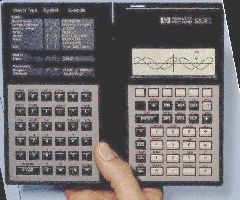
Of course, back in 1987, one could say that Hewlett-Packard was there first, with the HP-28C, pictured at right. That was succeeded in 1989 by the HP-28S, with more memory and a faster processor. This calculator also had a graphing capability, and symbolic algebra capabilities.
The HP-28C had a very limited symbolic integration capability: it could perform symbolic integration of polynomial expressions, and it could also use Taylor series to obtain integrals for other expressions. The TI-92, on the other hand, used the same basic algorithm as was used in Macsyma or Mathematica, giving it extensive symbolic integration capabilities.
One gadget with a microprocessor in it, the video game console, comes very close to being a home computer; it just lacks a keyboard as a peripheral, and usually, at least at first, ran programs on ROM cartridges instead of on disks or cassettes.
One of the earliest video games consoles was the Atari 2600. The photograph below
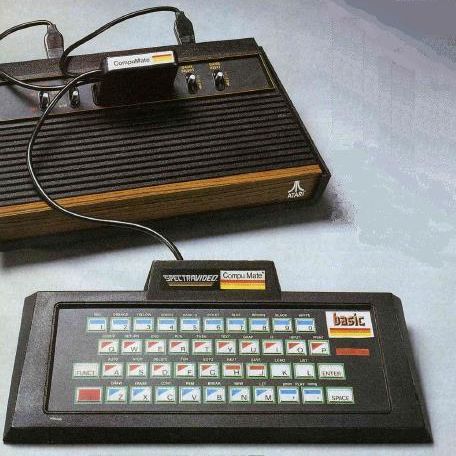
from an advertisement for the SpectraVideo CompuMate, shows one of those attached to an Atari 2600.
The Atari 2600 contained only 128 bytes of RAM, and used a MOS Technology 6507 as its CPU; this was a 6502 in a 28-pin package, so that some address lines were not available; it only had 8K rather than 64K of address space available, and some other functionality was omitted.
The cartridge connected a membrane keyboard to the video game, and provided additional RAM as well as ROM programs for BASIC as well as a music program and a paint program.
The rationale for this device was obvious: if you already own a device that contains a CPU, and a means of allowing programs that run on it to draw on a video display, then since you already have most of the parts of the computer, why not add what remains to make full use of it?
One early video game console came with a keyboard built in, the Magnavox Odyssey 2, pictured below:

Yes, it was only a membrane keyboard, but that was an entirely reasonable design choice for what was primarily a video game.
Originally released in September 1978 in North America, the Magnavox Odyssey 2 used an Intel 8048 microcontroller as its CPU, and had only the 64 bytes of RAM which was provided within that chip, although game cartridges could provide additional RAM if it was required for a particular game, as was true of several other video game systems. Despite this video game console having a built-in keyboard, a cartridge with a BASIC interpreter was not provided for this video game console, one titled Computer Intro! was available that offered users the ability to enter and run short programs in machine language.
In Europe, Philips imported this video game console, and sold it with its own branding as the Philips G7000.
Another early video game console was the Bally Library Computer, later called the Bally Professional Arcade, and also known as the Bally Astrocade. This game console had limited success, because it was relatively expensive.
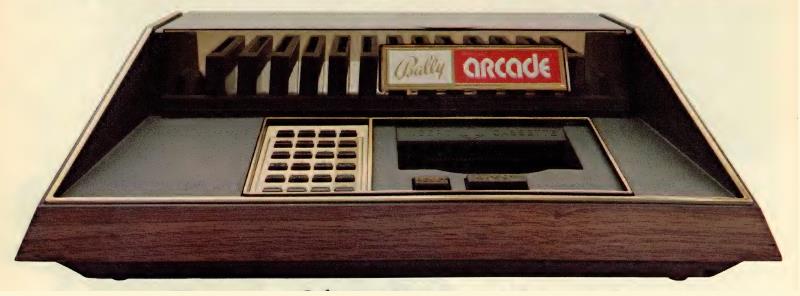
In addition to handheld controllers, it also had a calculator-like keyboard on the unit itself. It used a Z80 as its microprocessor. Also, it included some game programs which could be used without inserting a cartridge.
Like other video games, it used ROM cartridges, but they were about the size of audio cassettes, and they were referred to as program cassettes in advertising. Later, when a BASIC interpreter was offered for the unit on a cartridge, an adapter to allow a cassette tape to be connected for saving programs was included in the package.
The BASIC interpreter placed demands on the unit's memory that were difficult to meet; rather than include extra RAM on the cartridge, as some systems did, the problem was solved by putting the user's program in video memory; this was made possible by using only two colors instead of four.
An attempt was made to make an Astrology cartridge for the system; while it was able to calculate the positions of the planets for a given date, though, interpreting their astrological meaning was far beyond the capabilities of the hardwere, and so this was shelved. A cartridge to enable one to play Chess with the machine was also announced, but never made it to market. As the system used a Z80 as its CPU, it made sense to try to exploit the fact that it was more powerful than competing systems, but it would also have needed more RAM to allow that to be fully realized - but the system was already at a disadvantage due to being more expensive.
And the obvious remedy - put extra RAM in cartrides for more advanced games - was not really available. Cartridges with RAM in the early days were usually larger than ordinary cartridges - but on the Bally machine, the cartridges went into a compartment that fully enclosed them on all sides, instead of sticking into a slot on one side.
The earliest video game console to take game cartridges, however, was the Fairchild Video Entertainment System, which was renamed the Fairchild Channel F after the Atari 2600 Video Computer System came out, to avoid confusion.

Because it was the first one, its processor and graphics capabilities may have been a bit lacking compared to those of its subsequent competition; for whatever reason, the games available for it tended not to be as exciting as what the competition offered, which led to a lack of success for it.
The image below shows a Mattel Intellivision embedded in the Keyboard Component offered for it:
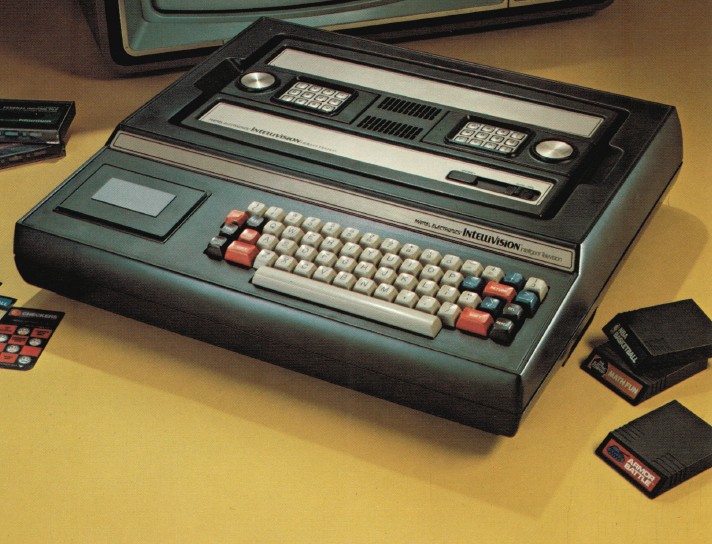
Once again, the idea was that since a video game already contained much of what makes up a computer system, it only makes sense to offer a way of making full use of those capabilities. The Keyboard Component, though, looks big enough to contain an entire computer by itself instead of making use of the video game console; for example, it's larger than a Commodore 64 or a VIC-20.
It is beautiful in appearance, and has an impressive keyboard.
A very few units of this original Keyboard Component reached the market after a long delay, due to problems with the supplier; this landed Mattel in hot water with the FTC because of the emphasis on the future availability of the Keyboard Component in its advertising.
Later, a much more compact unit with a different design was sold by Mattel for the purpose of turning an Intellivision video game into a home computer, but not many of those ended up being sold either.

Shown at left, in an image graciously placed in the public domain by Amos Evan, is the SONY PlayStation 3 video game console, which became available in November of 2006, first in Japan, and then a few days later in that same month in North America.
This video game used as its processor the CELL processor, jointly developed by IBM and SONY. This microcomputer included both a PowerPC CPU, and eight subordinate CPUs with a different instruction set, consisting only of SIMD vector operations. These subordinate CPUs could only access their own memories which were internal to the computer chip; only the main PowerPC CPU could access external RAM.
IBM was very optimistic about the prospects for the CELL processor, claiming initially that it would change the landscape of computing.
The processors used in the PlayStation 3 would have one core disabled; the intent was to make the video game affordable by initially using reject CELL chips with a defect in one of the subordinate processors; later, as yields went up and prices went down, perfectly good chips with one disabled core for market differentiation would be used, no doubt.
Of the seven available subordinate processors, one was dedicated to security-related tasks, leaving six for the use of the game developer.
The great power of the CELL processor led to SONY initially designing the software of the PS3 so that it was possible for a Linux distribution to run on that video game, and one was available, Yellow Dog Linux.
The United States Air Force Research Laboratory even built a supercomputer out of 1,760 SONY PlayStation 3 consoles; that was capable of 500 teraflops, and because it took advantage of the bargain price of the PS3 compared to rack-mountable server hardware based on the CELL processor, it was a very inexpensive computer for its power.
Unfortunately, later on, due to concerns about game piracy, SONY updated the firmware of the PS3 without warning to make the use of this sort of external software no longer possible. This was, naturally, upsetting to many PS3 owners, thus leading to both a controversy and a lawsuit.
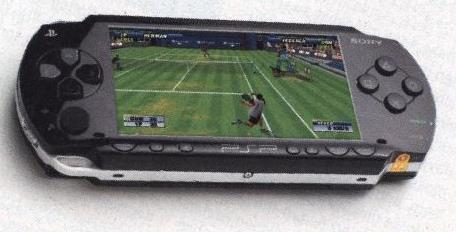
Video games that could be carried around in one's pocket were hardly new when the PSP, shown at right, became first available in North America on March 24, 2005. For example, there was the famous Nintendo Game Boy.
However, the PSP was a very impressive handheld device. A high-resolution screen. Programs weren't distributed on cartridges, but on small-sized optical discs combining DVD technology with advanced data compression, so you could buy UMD discs for the PSP with movies on them. These discs were 64 mm in diameter, and were inside of a protective carrier; their data capacity was 900 megabytes, which could be doubled for dual-layer discs.
It even includes a web browser.
The microprocessor democratized computing, by bringing down its cost a great deal. But that doesn't mean that everything that had a microprocessor in it was something you could own yourself. So, for example, you can visit some shopping malls and consult an interactive display showing a map of the lcoations of the available stores.
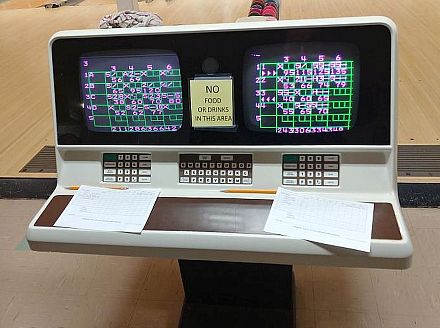
I will start this category off with just a single example. This example illustrates that there are more ways to use a computer recreationally than playing a video game running on a computer; the computer can also serve those engaging in sports. The image at left is a photograph I took myself on the occasion of visiting a small neighborhood bowling alley with a friend.
I was properly astonished to see the scores of the bowlers being displayed on color CRTs in this day and age. (I will not name the bowling alley, to prevent it from being overwhelmed by retrocomputing enthusiasts!)
Although there was no plaque on the device, when I looked at its back, to identify it, it turned out that this particular type of scoring console was once so common that I was easily able to find out more information on it through a web search. It turns out that this is the scoring console for a pair of Brunswick AS-80 bowling lanes. This type of bowling lane with automatic scoring was introduced in 1983, making it 40-year-old technology when I saw it still in use. That year, of course, was after the IBM PC, but before the IBM PC AT and the Macintosh.
While automatic pinsetters were first introduced in the 1950s, the first automatic scoring system that made use of information from the pinsetters made its appearance in 1967, after being developed through several years of research.
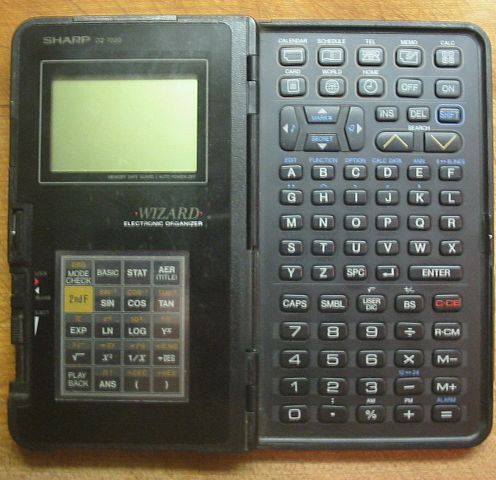
The SHARP IQ-7000 personal organizer (sold as the SHARP OZ-7000 WIZARD personal organizer in the United States), although it had an LCD display with 11 lines of 40 characters, was considered an amazingly impressive device in 1989, when it was introduced.
Program cards, which could be seen behind a transparent touchpanel, could give it additional functions; the one in the illustration let you program the organizer in BASIC, making it a full-fledged computer one could put in your pocket.
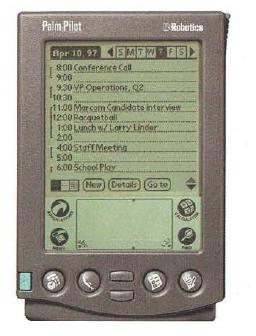
Later, in 1997, the Palm Pilot was introduced. This licensed some aspects of its user interface from the Macintosh, and it was much smaller and lighter than the SHARP organizer from a few years back, and had a much larger graphical sclreen.
Of course, there were also inexpensive personal organizers which were less capable, being digital address books rather than pocket computer systems.
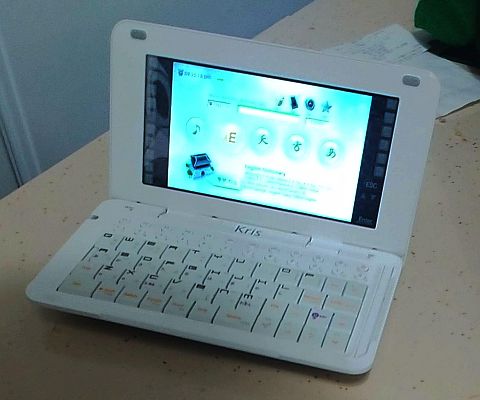
On the left is a photo of a Nurian Kris HNB-X41 pocket translator. This device could be used by speakers of Chinese, Japanese, or Korean to translate from other languages to their own. Although it looks like a laptop computer, it is closer in size to a smartphone, being only about 6 1/4" across.
This translator was made by a Chinese company for sale under its own brand name, but similar devices were designed by companies in other countries.
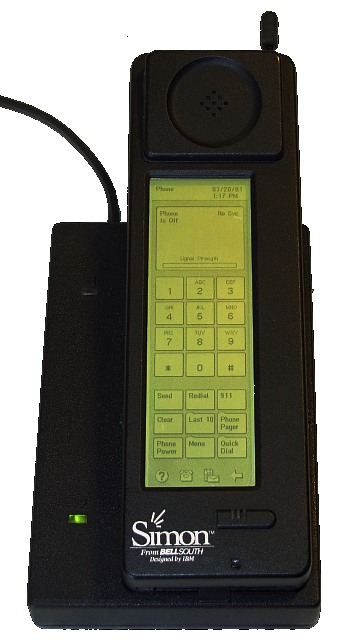
the smartphone in your pocket.
Pictured at right (in a public-domain image available through Wikipedia; I have altered the colors in the image to make the contents of the display of the device more visible) is the IBM Simon Personal Communicator. This device was introduced in August, 1994. It was exclusively distributed through BellSouth. It was manufactured for IBM by Mitsubishi, and its processor was a NEC V30 core, which was 8086-compatible, in a system-on-a-chip.
This was the first smartphone, but it was less than successful. Later, Nokia, Samsung, and Mindspring (the successor to the makers of the Palm Pilot) made somewhat more successful devices that also had the elements of a smartphone.
Many different approaches to the design of a mobile phone were tried; one notable one was the dual-hinge arrangement of the Motorola MPx from 2004, pictured below:
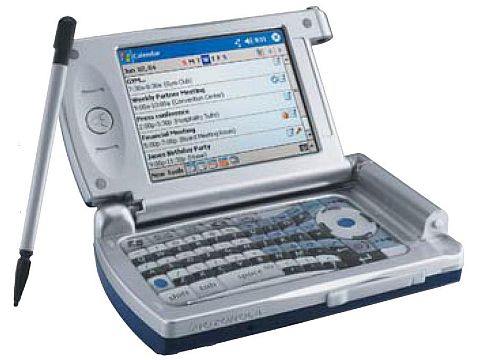
The display is electrically connected to the keyboard through the L-shaped hinge element near the bottom right of the display as shown. When the display is folded down to close the phone, it can be opened either in the manner shown, or it can be opened to the right instead of upwards, opening the phone as a flip phone. In either orientation, a stud will lock into a hole in the other part of the phone so as to create a hinge going across the width of the phone, so that it is always open in only one or the other orientation.
The Samsung Alias was another early mobile phone with a dual-hinge configuration.
However, the product category of smartphones did not rocket to spectacular success until Apple introduced the iPhone, which was announced on January 9, 2007 and which became available on June 29, 2007.
It was in September 2008 that the HTC Dream, which had a built-in keyboard that the display slid to the right (but upwards relative to the keyboard) to reveal, was made available, it being the first Android-based smartphone. Android had been in development for some time before the iPhone was announced, and so it was originally designed to work with a keypad, but with the arrival of the first iPhone, changes were quickly made to Android to allow support for smartphones with only a touchscreen. (There was a touchscreen-only smartphone available before the iPhone, the LG Prada. However, the operating system it used was lacking in some important respects, and for this and other reasons, the product was not a success and was largely forgotten.)
While the capabilities of a typical smartphone aren't unlimited, which is why people still spend money on flagship smartphones, desktop computers, or petascale supercomputers, or even exascale supercomputers, they certainly are so impressive that, by comparison, many of the impressive computers and computer-related devices of the past that were impressive in their day hardly seem impressive.
Of course, for tasks like content creation, one does want to have a big screen, a mouse, and an actual keyboard; a small touch screen will be too awkward. But while a smartphone can't quite do everything, it can do so much.
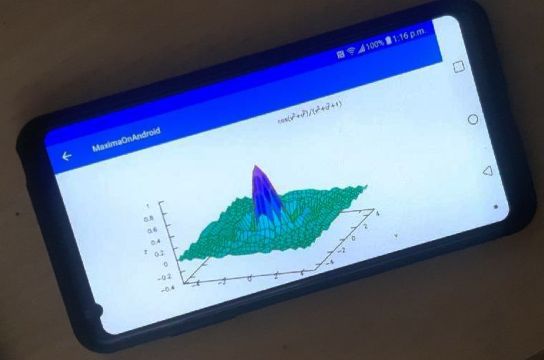
Pictured at left is the sort of thing one can do with a smartphone these days, although it's harder to explain why one might want to. However, if you really need to find an integral, and your smartphone is the only thing you have with you, the application Maxima on Android might even be a lifesaver.
The image you see was obtained by typing:
plot3d ( cos(u^2 + v^2) / (u^2 + v^2 + 1), [u, -5, 5], [v, -5, 5] );
incidentally.

Pictured at right is what the graph obtained from that command looks like when it is typed from the comfort of one's desktop instead.
Not that it matters terribly, but the smartphone in the picture is an LG Electronics V30. This means that its processor is a Qualcomm Snapdragon 835 chip, manufactured on 10nm technology.
It has eight Kryo 280 cores, although four of them run at a slightly higher speed than the other four (2.45 GHz as against 1.9 GHz) which seems a rather odd application of the big.LITTLE principle. Oh, silly me: now I see what they're doing. A typical octa-core smartphone processor would have four powerful cores of one design, and four weak cores of another design that consume much less power, so that it only uses the good cores when it has to. This phone doesn't bother with that. But it does use four cores when it can, and all eight cores only when it has to. And so, while it can run four cores at 2.45 GHz without getting too hot, when running all eight cores, it needs to step down the speed slightly to 1.9 GHz. And so the additional four cores need only be specified at 1.9 GHz!
Well, maybe not. Looking into this more deeply, I see that the Kryo 265 model number was used for Kryo 265 Gold cores, which were modified from the Cortex-A73, and for Kryo 265 Silver cores, which were derived from the Cortex-A53. So although all the cores of the Snapdragon 680 were Kryo 265 cores, they were still two different kinds of cores. On the page where I learned this, the cores of the Snapdragon 835 are called Kryo 280 Performance and Kryo 280 Efficiency cores, so they, as well, could be two different designs varying much more in performance than the clock speeds would indicate.
The Snapdragon 835 was also used in the Samsung Galaxy S8 smartphone.